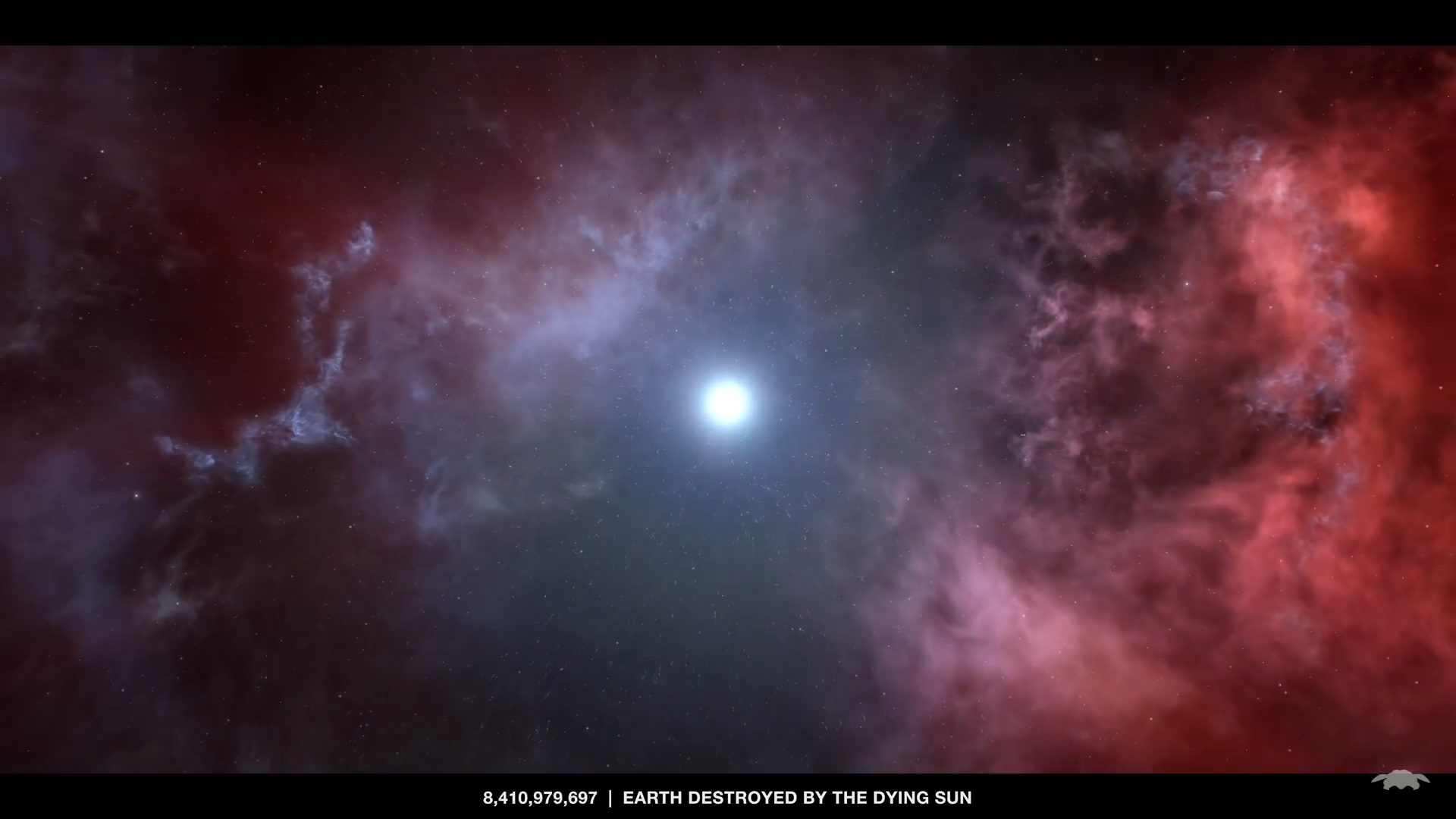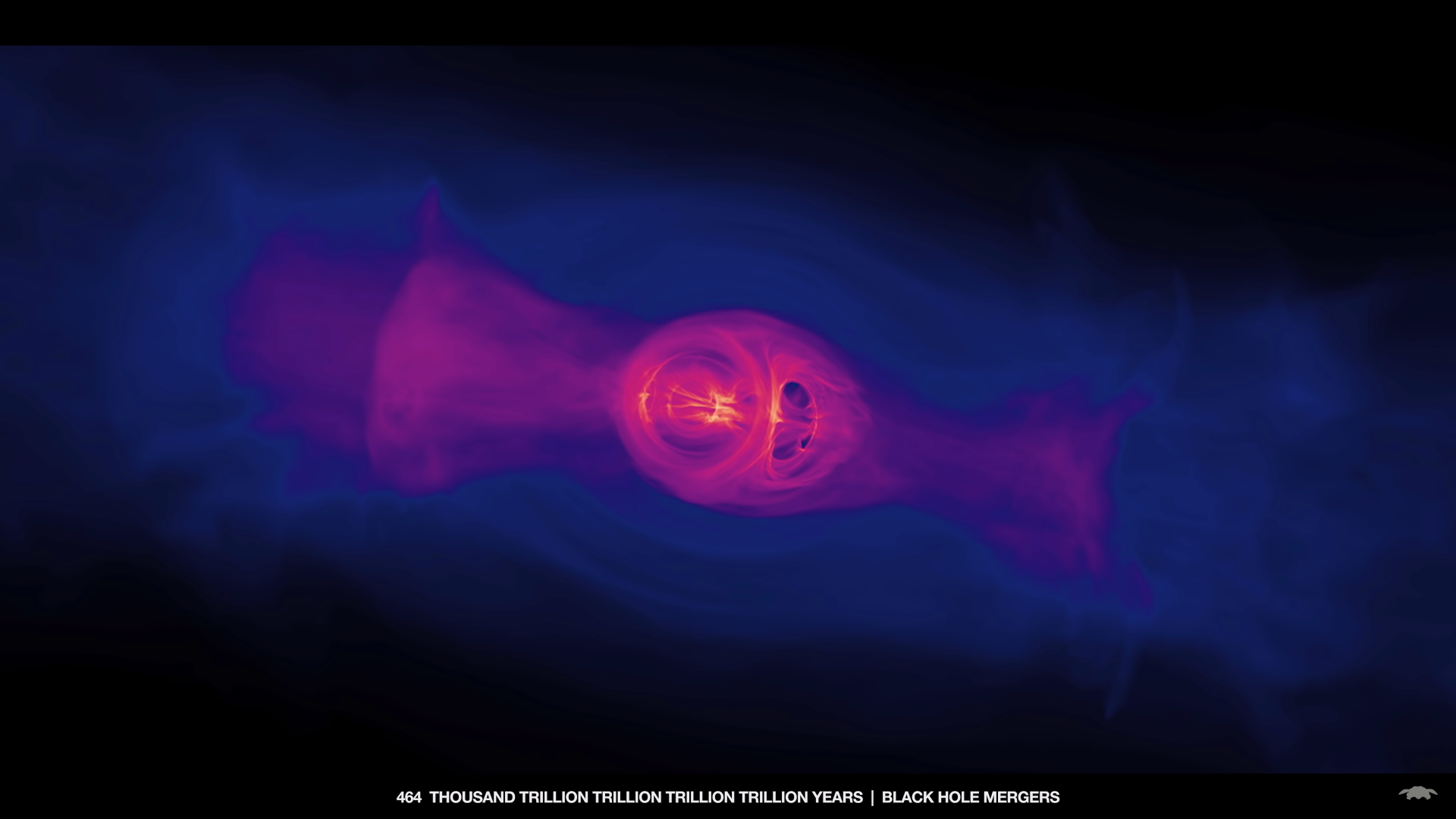This much is certain: The sun, like all stars, will one day die. Its demise will begin five billion years from now, when it starts running out of fuel. It will slowly bloat into a red giant, becoming over two hundred times larger than it is today and thousands of times more luminous. As it expands, it will consume nearby planets—including, most probably, our own. After devouring the planets it helped sustain, it too will die.
This cosmic fate—distant, inconceivable, and inevitable, all at once—occurs only three minutes into Melodysheep’s half-hour-long video, Timelapse of the Future: A Journey to the End of Time. The viewer hears the voice of British physicist Brian Cox coolly narrate the end of life as we know it while the incendiary expanding fireball of the sun swallows up Earth. A counter on the bottom of the screen adds to the tension, moving exponentially through time by doubling every five seconds. The description next to the counter (“EARTH DESTROYED BY THE DYING SUN”) is chillingly matter-of-fact.

The effect of this demise coming so early in the video is unsettling, akin to Hitchcock killing off Janet Leigh’s character less than a third of the way through Psycho. What comes next, now that the top-billed star has met its end?
Quite a lot, it turns out. If Timelapse of the Future has any message, it’s this: the universe has only just begun. Cosmic milestones whizz by in dizzying fashion as the timelapse reaches trillions of trillions of years into the future: stars begin to die off, neutron stars collide, black holes swallow stray matter, atoms decay, and the universe cools into a void of nothingness. The computer-generated visuals are complemented by narration from some of the world’s foremost cosmologists, helping provide perspective for what are strange times ahead, indeed.

This is heady stuff, and not the kind of material you’d think would go viral on YouTube (The video currently sits at 7.5 million views). But MelodySheep, whose real name is John D. Boswell, has made a career out of remixing science and making it palatable for the masses. His first hits were catchy three-to-five-minute-long music videos that featured auto-tuned raps from scientists like Carl Sagan, Stephen Hawking, and Richard Feynman as they held forth on quantum physics, Mars, and our place in the cosmos. Boswell’s videos splice together from clips from science documentaries and lectures, and feature music and animations Boswell creates himself.
“That sense of wonder you have as a kid? It never goes away,” Boswell said in a 2016 talk. “It just needs to be rekindled in the right way. Dinosaurs and space are just as cool to adults as they are for kids.” Boswell sees his science videos as a way to “spark that wonder again in people it might have faded for.”
But he’s never made a video longer, or more cosmically out there, than Timelapse of the Future. Creating it required months of research into physical cosmology, where speculations about the ultimate fate of the universe are legion, and often contradictory. Watching it requires a commitment that goes beyond the normal social media attention span, and a willingness to countenance our smallness in the face of long-lasting cosmic forces.
Boswell is surprised that the video has garnered millions of views. But he has a few ideas as to why it’s resonated.
This interview has been edited and condensed for clarity.

Long Now: What inspired you to make this video?
Melodysheep: I was inspired by the cosmic calendar that Carl Sagan talked about in Cosmos. In that mental construct, imagining all of universal history as a single calendar year, humans occupy the last hour of the last day. That was always a total mindfuck to me. I made a YouTube version exploring the idea of the cosmic calendar called Timelapse of the Entire Universe. It was my first long-term piece on YouTube. After I finished that, the obvious question that lingered was: Well, what’s next? What’s the next second of this timeline going to be like?
My original plan was to make something more like an art installation piece where there wouldn’t be so much talking and facts; it would basically just be the timeline and some chill music and meditative imagery of black holes that would just span for like 10 minutes at a time, and you’d get this abstract impression of how long the future is going to be, and how much emptiness there is. But the more I dug into it, the more I found there’s so much to talk about, and so much to say, that it would be foolish to waste this opportunity. I had a draft of this last summer, and felt it needed to be taken to the next level. So I spent another six months really digging into the VFX of it all, and the research, and figuring out how to build the flow of it and the structure and how to make it work. And I am glad I did. There’s just so much to say, and so much I had to leave out. But it came together really well and I am pretty stoked about how it turned out.
Long Now: Were you surprised that millions of people were willing to watch a 30 minute video about black holes, dark matter and developments that are trillions and trillions of years into the future?
Melodysheep: Truly, I did not expect this response at all. When I was making it I thought, “Who’s going to watch this? Who’s going to sit down for half an hour on YouTube and take the time and digest all this stuff?” But I’ve been pleasantly surprised with the reaction. People seem to be attentive to it, and I try to draw people’s attention through the whole time. I don’t want any lulls.
Long Now: Why do you think it resonated?
Melodysheep: I think there’s just something about the fate of everything that is really intriguing to people. You can’t quite look away; you’ve got to know how it ends.
Long Now: The exponential counter on the bottom, which doubles its journey through time every five seconds, certainly adds to the tension of the piece. What led you to make that choice advancing exponentially?
Melodysheep: The counter used in Timelapse of the Entire Universe was pretty straightforward; every minute corresponded to roughly a billion years. The exponential counter in Timelapse of the Future took a lot more thought and trickery. I chose one doubling of time every five seconds. It could have been every three seconds, and the video would have been over in fifteen minutes. But then you’re really cramming a ton of stuff into the first few minutes. Everything from the present day to the death of the earth would’ve occurred in one minute instead of three to four. That would’ve made it really hard to breathe. But then you have to apply that same rule to the rest of the video, and ensure you’ve got enough stuff in there to fill the time. It’s a balance.
Long Now: You’re engaging with a lot of speculative futures. What creative choices did you make to fill in the gaps in our knowledge about what might happen in the deep future, or deal with contradicting theories?
Melodysheep: That was a challenge. There’s so much to say in the first few minutes. And then the last fifteen minutes or so, there’s basically nothing to say. I had a breakthrough when I realized that I didn’t have to focus on just events that are actually happening, but could discuss theoretical stuff as well. I could step away from the physical events and talk about the metaverse and these bigger ideas while letting the counter run in the background.
Otherwise it would just be black for half the video, you know? There would be black holes here and there, but it would just be this empty void with these millions of black holes just sitting in silence doing nothing for trillions and trillions of years. So that was my creative workaround, and it seemed to work.
In terms of what I chose to fill in the gaps, it was just a matter of doing the research and digging in and seeing what I could find, because there’s so many predictions about what’s going to happen. And, like you said, some of them do contradict. Especially regarding climate change. It’s very speculative. I had Antarctica melting at 50 million years or so, but that could happen in the next ten thousand years. No one’s really quite sure. It’s guaranteed you’re going to have to do a lot of speculation anyway, so I’m not too concerned about scientific accuracy when it’s impossible to predict the future.
Long Now: You’ve received a lot of feedback from people who found the video depressing or existentially bleak, mostly along the lines of: “Why does anything matter at all, if ultimately Earth will be destroyed, the sun will die, and the universe will end in a cold freeze?” I suspect you don’t see it that way. How does the ultimate fate of the universe make you feel?
Melodysheep: I find it comforting. It’s beautiful in a way that the Big Bang was started from nothing and then at the end it’s going to be nothing all over again. There’s an arc to it that I find really poetic. I don’t fear the nothingness. If that’s really the way it is, then so be it. I think it puts everything in your life into perspective. It really is about the journey, not the destination. And we’re just here to live our moment in the sun as best as we can and enjoy it. It really highlights how special our moment in time is. We live in this moment when it’s not the early days of the universe, where it’s this completely homogenous fireball. And we’re not at the end of the universe where it’s this completely icy cold void with nothing in it. We’re in this Goldilocks moment. If we play our cards right, we potentially have trillions of years to live this moment and appreciate it as much as we can.
Learn More
- Watch more videos by Melodysheep here.
- Timelapse of the Future features audio from Craig Childs’ 02013 Long Now Seminar. Watch the full talk here.
- Former Long Now Seminar speaker Martin Rees is also featured in voiceover. Watch his recent Long Now talk here.
- Support for the video was provided by former Seminar speaker Juan Benet and his Protocol Labs. Watch Juan Benet’s full Long Now talk here.